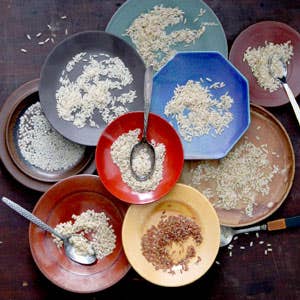
Types Of Brown Rice
Any variety of rice—whether it's the longer-grain types like those produced in the southern U.S. or the short- and medium-grain kinds like those Greg Massa and many other California farmers grow—can be milled to the brown rice stage. The nine rices discribed here represent a range of distinctive textures and flavors.
1. Some Asian producers package a version called quick-cooking brown rice, from which part of the bran has been milled off, cutting cooking time considerably; quick-cooking brands are sold online and at many Asian markets.
2. Widely available in supermarkets, long-grain brown rice, usually of the indica subspecies, requires more water and more time to cook but yields grains with a springy character that's nicely suited to casseroles and other baked dishes.
3. Medium-grain brown rice, usually of the japonica subspecies, tends to be stickier and more tender when cooked than long-grain rice; it's the most common type grown in Spain and is ideal for paellas.
4. Brown basmati rice, grown in South Asia, gets longer, not fatter, when cooked and develops a firm, dry consistency, making it perfect for biryanis and pilafs.
5. Aromatic jasmine rice has the elegant look of long-grain varieties but cooks up moist and tender, like a medium-grain rice; it's available at most Asian markets.
6. Nicknamed baby basmati, tiny kalijira rice grains could almost be mistaken for couscous; sold at Whole Foods markets, they're a fragrant, quick-cooking marvel.
7. Nutty-sweet red rice, also available at Whole Foods, owes its color to a pigment in its bran layers; some types are sweet enough to use in puddings.
8. Ideal for croquettes and risottos, short-grain brown rice, whose grains are barely longer than they are wide, can have an almost creamy texture when cooked.
9. Expensive and hard to find in the States, Japan's haiga-mai is a partially milled rice from which the bran has been removed but not the nutrient-packed germ, or embryo.
Keep Reading
Continue to Next Story










